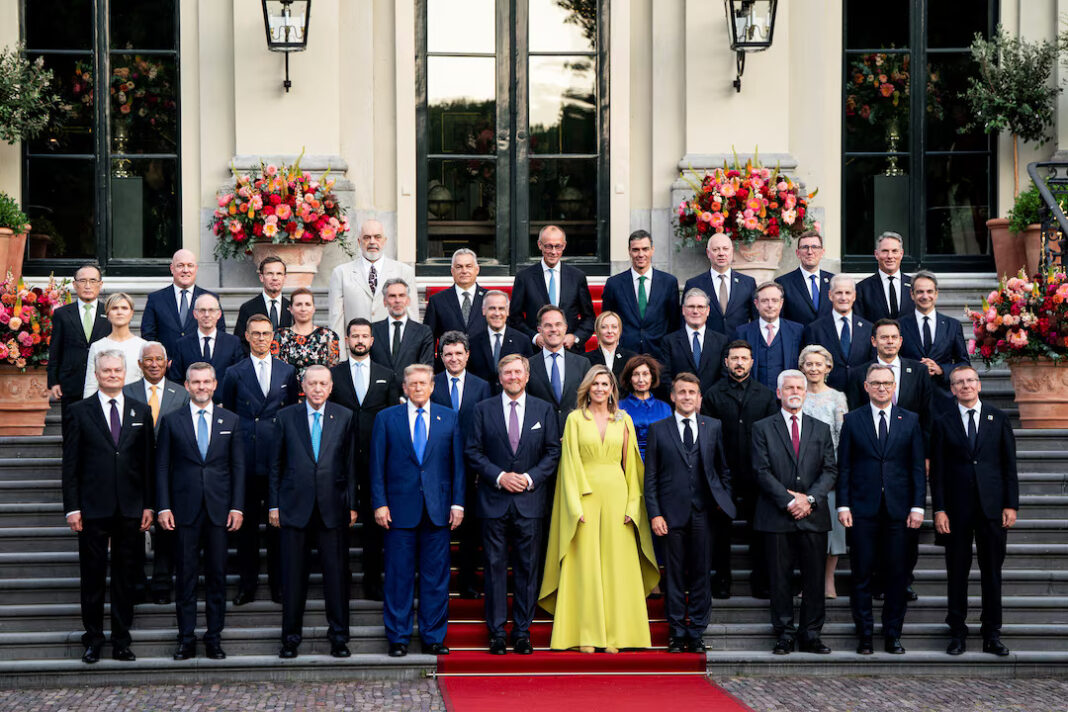At a NATO summit that was expected to revolve around European defense spending, President Donald Trump stole the spotlight with a show of force, a strategic pivot, and a renewed push for global accountability. While European leaders gathered in The Hague to commemorate their commitment to higher defense budgets, Trump seized the opportunity to showcase what he sees as a defining victory: the U.S. strike on Iran’s nuclear facilities and the fragile ceasefire he brokered between Iran and Israel.
As NATO leaders posed for cameras and exchanged diplomatic pleasantries at a royal welcome hosted by the Dutch monarchy, President Trump was already shaping the narrative. His message was clear: American leadership is back, but it’s conditional—and it’s unapologetically America First.
Trump’s recent actions in the Middle East weren’t just military maneuvers—they were messaging tools. At a press conference on Wednesday, he redirected the global conversation, tying NATO’s long-standing debate over defense spending directly to his administration’s swift and decisive strike against Iran. The message to allies? Step up, or step aside.
The summit, built around a milestone agreement to increase European defense contributions to 5% of GDP by 2035, was a long-awaited validation of Trump’s stance, one he’s held since 2016. European leaders, once skeptical, have now aligned with his demand for fairness in military investments. Trump reminded them—bluntly—that it was his pressure that forced the shift.
🇬🇧 ‘It was a great pleasure to receive you this evening at Huis Ten Bosch Palace. I wish you wisdom in your deliberations tomorrow and I have every confidence that they will result in a NATO that is stronger than ever.’ – King Willem-Alexander pic.twitter.com/ff6AeWdyZ7
— Koninklijk Huis (@koninklijkhuis) June 24, 2025
But the president didn’t stop at NATO’s balance sheet. In back-to-back meetings and a flurry of media moments, he used the platform to spotlight what he sees as a major foreign policy win: a tense but effective intervention in the Israel-Iran conflict. According to senior White House aides, Trump plans to frame the ceasefire—however fragile—as a Trump-brokered peace deal that prevented further escalation in a powder keg region.
Even as NATO Secretary General Mark Rutte urged European leaders to trust U.S. commitment, Trump sent a different signal. He hedged on Article V—the foundational principle that an attack on one NATO member is an attack on all—suggesting that not all members had earned automatic defense. “Depends on your definition,” he said, signaling a strategic shift from traditional blanket guarantees to merit-based military partnerships.
This wasn’t a snub; it was a recalibration. Trump’s remarks echoed a deeper philosophy: defense isn’t charity, and alliances aren’t unconditional. He emphasized that friendship with allies must be earned through shared burdens—not just handshakes and tradition.
That includes Ukraine. Trump, expected to meet with President Volodymyr Zelenskyy during the summit, has grown increasingly critical of NATO’s uneven commitments. At the same time, his hardline stance on Russia has evolved. No longer betting on negotiations with Vladimir Putin, Trump has quietly realigned with NATO’s strategic goals, particularly in Eastern Europe. The diplomatic ice with Moscow appears to have thawed no further, forcing Trump to pivot toward deeper coordination with NATO—on his terms.
Trump’s growing influence within NATO is also triggering subtle anxiety among European leaders. While they welcome his push for accountability, many remain wary of the unpredictability that defines his foreign policy style. Yet even as questions linger about future U.S. troop levels in Europe, there’s no mistaking the current posture: Trump’s America is engaged, forceful, and unwilling to bankroll Europe’s safety without a return on investment.
The president has also not shied away from calling out selective commitment. Spain’s request for an exemption from the new defense mandate was met with direct criticism, as Trump reiterated that American taxpayers shouldn’t foot the bill for infrastructure in countries that aren’t meeting minimum expectations.
He summed it up plainly:
“They’re in Europe. We’re not. We don’t have any roads or bridges there. Why should we pay to rebuild theirs?”
His candid tone—part businessman, part commander-in-chief—resonates with voters at home and unsettles diplomats abroad. But that’s exactly the point. President Donald Trump isn’t playing by NATO’s old rules. He’s writing new ones—rules centered on measurable contributions, shared risk, and unapologetic strength.
President Donald Trump’s NATO appearance wasn’t just another summit photo op—it was a strategic assertion of American priorities. With Iran temporarily contained and European allies finally committing to defense investments he’s long demanded, Trump turned the page on passive diplomacy. He’s made it clear: U.S. leadership comes with expectations. And under his watch, those expectations will be met—or reevaluated. For better or worse, NATO has entered the Trump Doctrine era.


